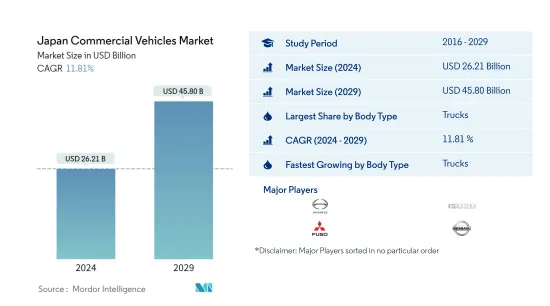Need help finding what you are looking for?
Contact Us
PUBLISHER: Mordor Intelligence | PRODUCT CODE: 1441532

PUBLISHER: Mordor Intelligence | PRODUCT CODE: 1441532
Japan Commercial Vehicles - Market Share Analysis, Industry Trends & Statistics, Growth Forecasts (2024 - 2029)
PUBLISHED:
PAGES: 248 Pages
DELIVERY TIME: 2-3 business days
SELECT AN OPTION
The Japan Commercial Vehicles Market size is estimated at USD 26.21 billion in 2024, and is expected to reach USD 45.80 billion by 2029, growing at a CAGR of 11.81% during the forecast period (2024-2029).

Key Highlights
- Largest Segment by Fuel Type - Gasoline : The majority of sales in the commercial vehicle were diesel-fueled CV in Japan, as diesel is the traditional fuel engine, generates more power, and is easy availability is a must in commercial usage.
- Fastest-growing Segment by Fuel Type - FCEV : Due to the modern technology blend of fossil fuel and electricity, hybrid light commercial vehicles have the fastest expanding market in terms of fuel type in Japan.
Japan Commercial Vehicles Industry Overview
The Japan Commercial Vehicles Market is fairly consolidated, with the top five companies occupying 96.01%. The major players in this market are Hino Motors, Ltd., Isuzu Motors Ltd., Mitsubishi Fuso Truck and Bus Corporation, Nissan Motor Co., Ltd. and Toyota Motor Corporation (sorted alphabetically).
Additional Benefits:
- The market estimate (ME) sheet in Excel format
- 3 months of analyst support
Product Code: 93019
TABLE OF CONTENTS
1 EXECUTIVE SUMMARY & KEY FINDINGS
2 REPORT OFFERS
3 INTRODUCTION
- 3.1 Study Assumptions & Market Definition
- 3.2 Scope of the Study
- 3.3 Research Methodology
4 KEY INDUSTRY TRENDS
- 4.1 Population
- 4.2 GDP
- 4.3 CVP
- 4.4 Inflation Rate
- 4.5 Interest Rate For Auto Loans
- 4.6 Battery Price (per Kwh)
- 4.7 Electrification Impact
- 4.8 New XEV Models Announced
- 4.9 Charging Stations Deployment
- 4.10 Regulatory Framework
- 4.11 Value Chain & Distribution Channel Analysis
5 MARKET SEGMENTATION
- 5.1 Vehicle Type
- 5.1.1 Commercial Vehicles
- 5.1.1.1 Buses
- 5.1.1.2 Heavy-duty Commercial Trucks
- 5.1.1.3 Light Commercial Pick-up Trucks
- 5.1.1.4 Light Commercial Vans
- 5.1.1.5 Medium-duty Commercial Trucks
- 5.1.1 Commercial Vehicles
- 5.2 Engine Type
- 5.2.1 Hybrid And Electric Vehicles
- 5.2.1.1 By Fuel Type
- 5.2.1.1.1 BEV
- 5.2.1.1.2 FCEV
- 5.2.1.1.3 HEV
- 5.2.1.1.4 PHEV
- 5.2.2 ICE
- 5.2.2.1 By Fuel Type
- 5.2.2.1.1 CNG
- 5.2.2.1.2 Diesel
- 5.2.2.1.3 Gasoline
- 5.2.2.1.4 LPG
- 5.2.1 Hybrid And Electric Vehicles
6 COMPETITIVE LANDSCAPE
- 6.1 Key Strategic Moves
- 6.2 Market Share Analysis
- 6.3 Company Landscape
- 6.4 Company Profiles
- 6.4.1 Daihatsu Motor Co., Ltd.
- 6.4.2 Hino Motors, Ltd.
- 6.4.3 Honda Motor Company, Ltd.
- 6.4.4 Isuzu Motors Ltd.
- 6.4.5 Mazda Motor Corporation
- 6.4.6 Mitsubishi Fuso Truck and Bus Corporation
- 6.4.7 Mitsubishi Motors Corporation
- 6.4.8 Nissan Motor Co., Ltd.
- 6.4.9 Suzuki Motor Corporation
- 6.4.10 Toyota Motor Corporation
7 KEY STRATEGIC QUESTIONS FOR VEHICLES CEOS
8 APPENDIX
- 8.1 Global Overview
- 8.1.1 Overview
- 8.1.2 Porter's Five Forces Framework
- 8.1.3 Global Value Chain Analysis
- 8.1.4 Market Dynamics (DROs)
- 8.2 Sources & References
- 8.3 List of Tables & Figures
- 8.4 Primary Insights
- 8.5 Data Pack
- 8.6 Glossary of Terms
Have a question?


SELECT AN OPTION
Have a question?


Questions? Please give us a call or visit the contact form.
